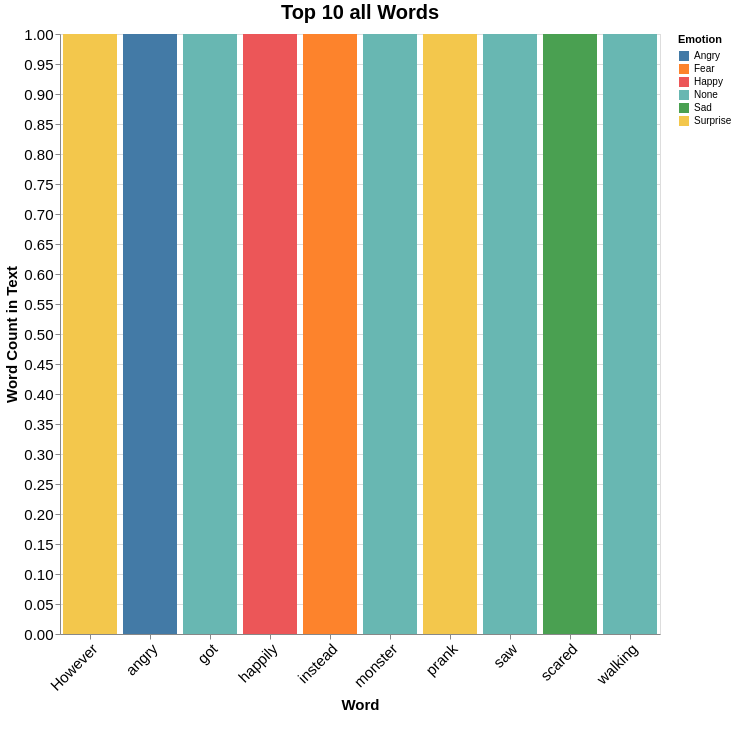Pyemoodji is a text analysis package that focuses on sentiment analysis in text files in quantitative and qualitative ways. Specifically, it is used for determining what kind of underlying emotion your input text gives off and quantitatives analyses of your text (character, word, and sentence count as well as visual and quantitative sentiment analysis). The emotions analyzed include angry, sad, happy, and disgust. Another core feature of Pyemoodji is it replaces words with emojis to provide the user with a text file where it is easier to pick up on the emotions being conveyed in a visually appealling snapshot view. This package can be useful when proofreading an important message which you want to elicit a certain emotion or tone, particularly with a given pattern or rhythm (speeches, letters, applications, songs, poems, etc).
$ pip install -i https://test.pypi.org/simple/ pyemoodjiCounter:
- With an input of textfile it will output a dataframe with character count, word count, and sentence count.
Sentiment Analysis Dataframe:
- With an input of a textfile it will output a dataframe with sentiment analysis (e.g. sentiment type, sentiment words, and percentage of overall sentiment per emotion).
Character Replacement:
- With the input of a textfile and the ability to choose which emotions you would like to replace (e.g. certain emotions or all) it will output a textfile that has emotional words replaced with emojis.
Sentiment Analysis Plot:
- With the input of a dataframe from the sentiment analysis function it will output a visualization on the most emotionally charged words that appear in the text.
- While tidytext (R) and nltk (Python) already exist, this package takes it a step further by providing qualitative sentiment analysis in a visually appealing format by replacing emotional words with emojis and further analyzing text data to provide more quantitative sentiment analysis.
- We also add visualizations to further this quantitative sentiment analysis in a way that these packages do not.
Here is a example of how this package could be used. Let's say there is a statement that you are trying to analyze. This is how you could implement our package.
First you need to import this package with the following command:
import pyemoodji
Let's say you have the following statement:
I was happily walking. I then saw a monster and I got scared. However, when I found out it was a prank I became angry instead.
To start you might want to first determine the number of characters, words, and sentences to ensure that your statement fits within guidelines.
pymoodji.counter('I was happily walking. I then saw a monster and I got scared. However, when I found out it was a prank I became angry instead.')
This would output a dataframe with the following values:
| char_count | word_count | sentence_count |
|---|---|---|
| 127 | 26 | 3 |
After you have some insight into the length of your statement you would want to get a dataframe that will provide you with some statistics about the emotional content of your statement.
pyemoodji.sentiment_df( "I was happily walking. I then saw a monster and I got scared. However, when I found out it was a prank I became angry instead." )
| word | key | emotion_count | emotion_percentage | word_count |
|---|---|---|---|---|
| monster | None | 0 | 0.000000 | 1.0 |
| walking | None | 0 | 0.000000 | 1.0 |
| instead | Fear | 1 | 0.166667 | 1.0 |
| saw | None | 0 | 0.000000 | 1.0 |
| I | None | 0 | 0.000000 | 5.0 |
| angry | Angry | 1 | 0.166667 | 1.0 |
| got | None | 0 | 0.000000 | 1.0 |
| However | Surprise | 1 | 0.166667 | 1.0 |
| scared | Sad | 1 | 0.166667 | 1.0 |
| prank | Surprise | 1 | 0.166667 | 1.0 |
| found | None | 0 | 0.000000 | 1.0 |
| became | None | 0 | 0.000000 | 1.0 |
| happily | Happy | 1 | 0.166667 | 1.0 |
Now you might want to take this tabular / text data and turn it into a data visualization so that you can better understand the breakdown of emotions used in your statement.
pyemoodji.sentiment_plot( "I was happily walking. I then saw a monster and I got scared. However, when I found out it was a prank I became angry instead.", sentiment="all" )
Also you could change the sentiment parameter to only see words with one type of sentiment
pyemoodji.sentiment_plot( "This week, show us a smile (yours or someone else's), make us smile, or both. Share a photo of something that has brought a moment of joy into your life recently, or focus on the outcome of that joy. If you're not feeling particularly cheerful at the moment — it's still 2018, after all — no need to fake your way into the challenge, either. Smiles come in all shades and flavors, including the half-hearted, tired, bitter, and resigned (to name a few). So whether the emotions you channel in your photo are full of cheer or not, I can't wait to see your take on this theme.", sentiment="happy" )
Lastly, you might want to visualize the emotions in this statement in a different way. This packages allows you to see the emotional words replaced with corresponding emojis for each type of emotion.
pyemoodji.textsentiment_to_emoji( "I was happily walking. I then saw a monster and I got scared. However, when I found out it was a prank I became angry instead." )
😃 😢 😮 😮 😡 😱
The official documentation is hosted on Read the Docs: https://pyemoodji.readthedocs.io/en/latest/
- TODO
This package was created with Cookiecutter and the UBC-MDS/cookiecutter-ubc-mds project template, modified from the pyOpenSci/cookiecutter-pyopensci project template and the audreyr/cookiecutter-pypackage.

